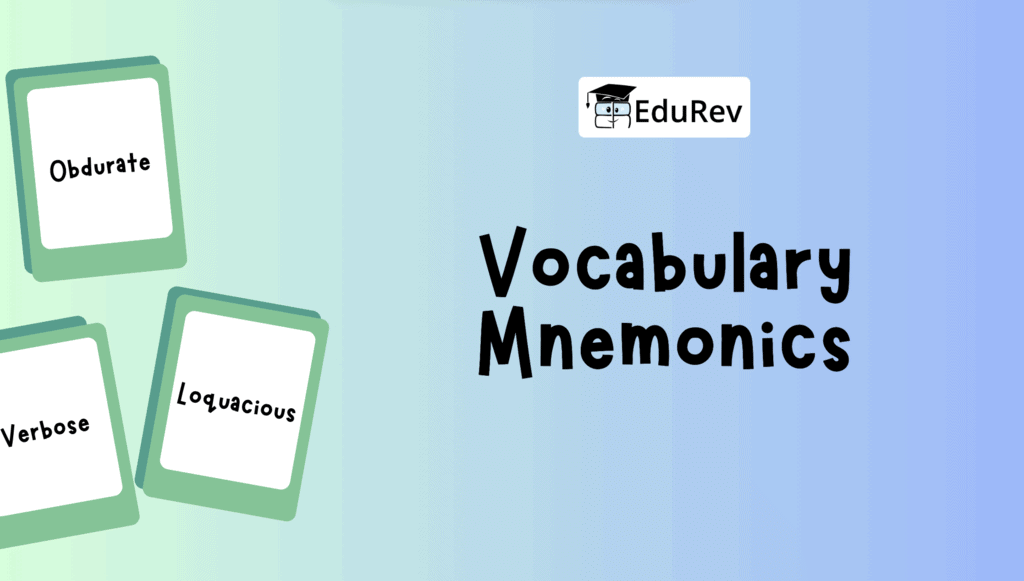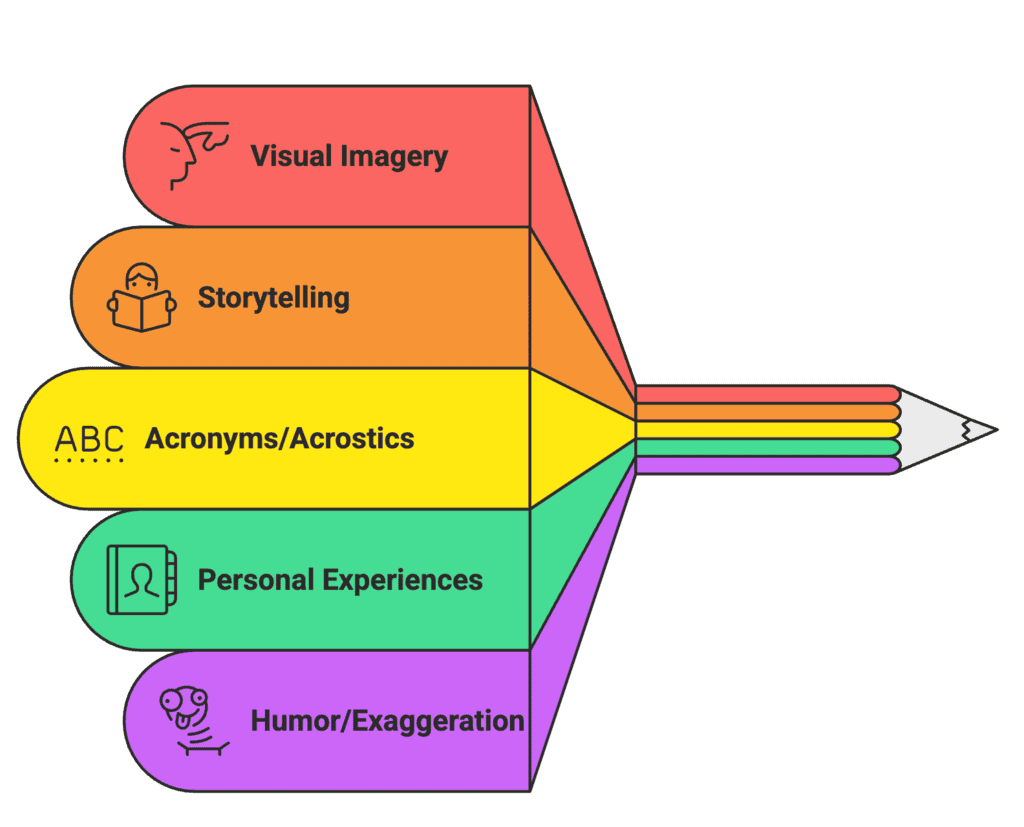Vocabulary Mnemonics | Verbal Ability & Reading Comprehension (VARC) - CAT PDF Download
Introduction
Learning new vocabulary can feel overwhelming at times, especially when trying to remember difficult words. A great way to make this process easier is by using mnemonics – memory tricks that help connect new words to familiar sounds, images, or ideas.
This document provides a set of helpful mnemonics for common vocabulary. Each word is paired with a fun and easy-to-remember hint, making it simpler to remember and enjoy learning new words. These mnemonics are here to help you recall important words and make learning more fun.

1. Common Adjectives
Alacrity – eager willingness
Mnemonic: Think “electricity” – when someone is full of electricity, they are eager and energetic.
Belligerent – aggressive, warlike
Mnemonic: “Bully + urgent” – a bully always wants to fight urgently.
Lethargic – sluggish, lacking energy
Mnemonic: “Lazy tiger” – imagine a tiger too tired to move.
Mendacious – dishonest
Mnemonic: “Men are suspicious” – (jokingly) linking men to lying.
Sagacious – wise
Mnemonic: “Sage + cautious” – a wise person is cautious in decisions.
Ubiquitous – present everywhere
Mnemonic: “Uber + quick to us” – Uber is everywhere!
2. Negative Traits
Nefarious – wicked, evil
Mnemonic: “Ne-fairy-ous” – the opposite of a fairy, i.e., evil.
Recalcitrant – stubbornly resistant
Mnemonic: “Re-calc-it-rant” – takes recalculating to stop the ranting of a stubborn person.
Obdurate – stubborn
Mnemonic: “Obvious + hard” – obviously hard to change.
Impetuous – impulsive
Mnemonic: “I + pet + us” – I impulsively bought a pet for us.
3. Speech & Communication
Garrulous – excessively talkative
Mnemonic: “Girls rule us” – (teasingly) they talk a lot.
Harangue – a loud, aggressive speech
Mnemonic: “Her + anger” – imagine someone yelling in anger.
Loquacious – very talkative
Mnemonic: Sounds like “low queue at tea stall” – because the man is too busy talking to serve!
Verbose – using too many words
Mnemonic: “Verbal overdose” – too many words.
4. Confusing or Complex Ideas
Cacophony – harsh, jarring noise
Mnemonic: “Caca (bad) + phony (sound)” – bad sound.
Obfuscate – to confuse
Mnemonic: “Obvious? Fake!” – what looks obvious is fake and confusing.
Quixotic – overly idealistic, unrealistic
Mnemonic: “Quick + exotic” dreams – unrealistic fantasies.
Equivocate – to be vague or misleading
Mnemonic: “Equal voices” – saying things that sound equal but mean nothing.
5. Praise & Criticism
Kudos – praise or recognition
Mnemonic: “Cool dose” – a cool dose of appreciation.
Deride – to mock or ridicule
Mnemonic: “De-ride” – take someone off a joy ride with mockery.
Vituperate – to scold harshly
Mnemonic: “Witty + super + rate” – a witty person scolds at a super rate.
Extol – to praise highly
Mnemonic: “Extra toll” – if someone does great, you pay an extra toll (praise).
6. Verbs of Action
Placate – to calm or pacify
Mnemonic: “Plate + cake” – offer cake to calm someone down.
Abrogate – to abolish or cancel
Mnemonic: “A broken gate” – the gate (law) is abolished.
Exacerbate – to make worse
Mnemonic: “Eggs + acid + bait” – adding these worsens a situation!
Mitigate – to make less severe
Mnemonic: “Mini gate” – a smaller gate reduces the risk of entry.
7. Comparisons & Contrasts
Juxtapose – to place side by side for contrast
Mnemonic: “Just next position” – place side by side.
Disparate – essentially different
Mnemonic: “This + separate” – things that are clearly not alike.
Analogous – similar
Mnemonic: “Analogue + us” – analogies are similar to us in structure.
Tips to Create Your Own Mnemonics

To create effective mnemonics, consider the following strategies:
- Use Visual Imagery: Associate the word with a vivid image. For example, for "hirsute" (covered with hair), imagine someone wearing a "hair suit."
- Create Stories: Craft a short story that includes the word and its meaning to make it memorable.
- Use Acronyms or Acrostics: For lists, create acronyms or sentences where each word starts with the same letter as the item to remember.
- Link to Personal Experiences: Connect the word to your own life to make it relatable.
- Exaggerate or Be Humorous: Use funny or exaggerated mnemonics to enhance recall.
|
113 videos|461 docs|90 tests
|
FAQs on Vocabulary Mnemonics - Verbal Ability & Reading Comprehension (VARC) - CAT
| 1. What are some effective ways to remember common adjectives in English? |  |
| 2. How can I identify and describe negative traits in a character? |  |
| 3. What are some tips for improving speech and communication skills? |  |
| 4. How do I simplify confusing or complex ideas for better understanding? |  |
| 5. What is the best way to give praise and criticism effectively? |  |
















